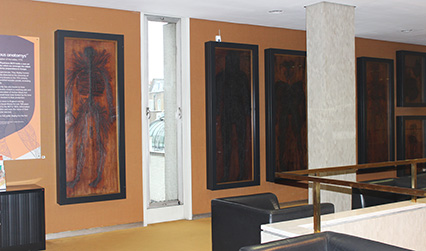For the first time ever one of the RCP’s rare 17th century anatomical tables is now available to view online with our new 3D model.
The set of six anatomical tables are some of the most impressive items in the RCP’s collections. Created in the 1660s, they are anatomical preparations that show human nerves, veins and arteries, varnished onto wooden panels, and are one of only two such sets known in the world.

Having seen other museums producing exciting digital models of their objects through 3D scanning, the RCP museum team decided to look into this for one of the tables. The 3D model makes it easier to see the incredible detail of the anatomical preparations right up close, and it also allows far more people to view it. Although the tables are on public display at the RCP headquarters, their current location on the second floor is sometimes missed by visitors, and it’s obviously only accessible to people who can come physically to visit the building in London. Now the model is online, it can be viewed around the world.
The table we selected to scan was the adult male nervous system, catalogue number X21. Although referred to as a ‘scan’, a 3D model is actually created from numerous photographs that are taken of the object from various different angles. These are then stitched together into a 3D digital model than allows you to move and zoom your view of the item, as though you are physically examining it.

Without an in-house technical team we had to out-source the actual scanning to a specialist company, sample & hold ltd. A date for the scanning was chosen and Chris from sample & hold turned up with huge amounts of equipment. Leaving him to set up, the next task for the museum team was to remove the table from its case, a job that as with a lot of museum work proved to be much more complicated than originally thought.
The tables had new, specially made cases built for them in 2012, providing increased protection and security in line with museum best practice. However, the current museum team hadn’t removed the nervous system table from its case before, and we discovered that the case fitted the table extremely well – so well in fact that we had trouble getting our hands in to remove it. Luckily the tables have all been set into more modern panels of wood, meaning that we were able to manipulate and handle them without damaging the actual tables themselves.

Next the table was delivered to Chris and his camera set-up, where it was propped carefully against the wall and the lights and equipment adjusted to provide the optimum set up for capturing the detail on the table. One full day and many photos later we returned the table to its case and waited to see the end result.
Once the data from the scanning was received it was a matter of learning to use the platform Sketchfab and of working closely with sample & hold in order to host and effectively display the 3D model of the table. The data provided from the scanning will also enable us to commission a 3D print of one of the hands from the table, so that visitors will be able to further explore this fascinating object. The full-colour 3D scan of the table is now available to view on the RCP museum’s Sketchfab profile, which we hope may eventually include further 3D models of items in our collection.
You can see the tables in person at the RCP headquarters on Regent's Park, London. The museum is usually open Monday–Friday, 9am–5pm, but please check for occasional closed days in advance of your visit
